Does painting have to be a matter of life and death?
By Elspeth C. Young
By Al R. Young
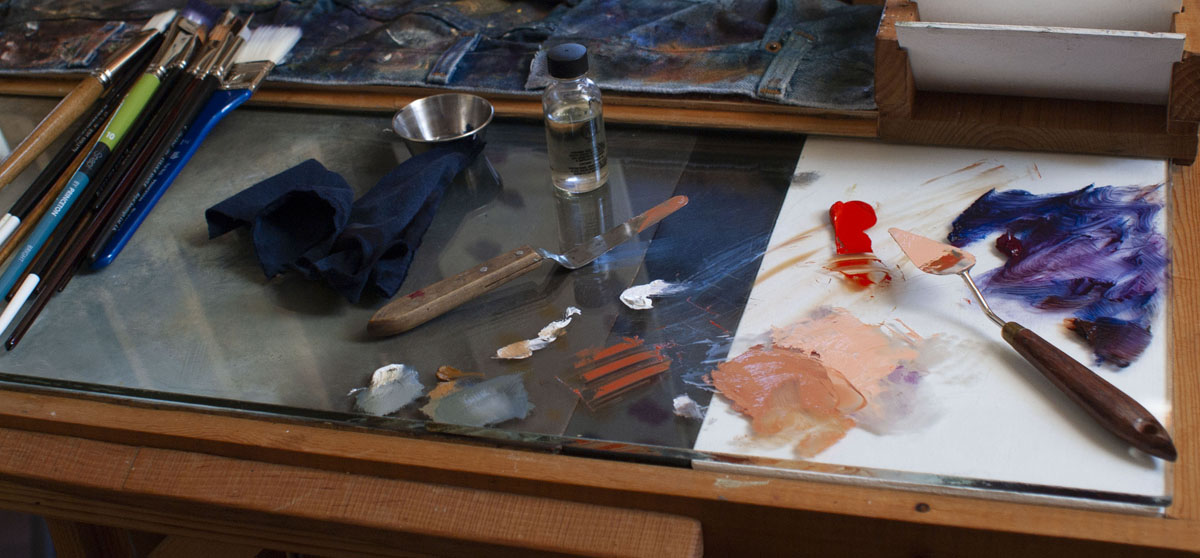
NOTE: This article focuses only on oil painting and, more specifically, oil painting as we approach the medium. While some of the statements, here, might be applied to other media, such as air brushing, acrylics, watercolors, etc., such application is entirely the responsibility of the reader. We also caution that even applying the following statements to oil painting is something for which the reader is also ultimately and totally responsible.
When I was very young, allergies and allergic reactions were as prominent a part life as breathing, which, because of asthma, was sometimes severely compromised. Very early on, allergies changed not only my life, but the life of everyone else at home. Eventually, a visit to the Loveless Clinic and a patch test there confirmed that, in summary, I was allergic to anything on the planet that was green and growing. And there were a great many other things besides. However, the strangest test result of all, as part of another test by another specialist, was the pronouncement that I was allergic to red.
Art and its creation were as foreign to the environment in which I was raised as going to college or attempting to earn a living in the arts. Consequently, there was no one to point out that perhaps my allergy to red – a color I quite liked – had nothing to do with the hue and everything to do with pigments. Additionally, it was allergies by which I was constrained to work almost exclusively in pencil, notwithstanding the powerful fascination I had for oils.
There is considerably more to this story, but suffice it to say that when I embarked on oil painting a great many years ago, the recommendation I received for a beginner's color palette focused only on colors (like the unexplained prohibition concerning the color red). I have no recollection of any attention having been focused on the chemistry of the colors, which, of course, has everything to do with toxicity and allergy. And apart from paint-tube labels telling me not to paint in California, I didn't feel compelled to pay much attention to the chemistry of grounds, paints, media, solvents, sealers, or anything else.. Not, that is, until Elspeth had heard the cancer-word spoken one too many times in histories involving our family tree.
Chemistry is something for which Elspeth has long enjoyed a natural and acute interest, but even with the advent of chronic leukemia on my part and her discovery of an intense allergy to anything blue, we more or less coasted along with palettes and media unchanged. Then, about two years ago, Elspeth discovered that some long-standing problems she dealt with actually stemmed from an acute allergy to benzene.
The discovery of the allergy was only the beginning because, in today's world, being allergic to benzene is as bad as being allergic to all forms of plant material. Benzene is in everything. "Benz" in a product name usually signals that benzene is a component; nevertheless, the absence of "benz" is by no means definitive in answering questions about its presence. For example, benzene is used in manufacturing plastics, detergents, soaps, fabric softeners, cleansers, disinfectants, and just about every substance involved in what contemporary society views as progress.
In terms of allergic reaction, we're not talking about things like sneezing and sinus drainage, although those were problems, but disabling migraine-style headaches, severe nosebleeds, and acute tension often lasting for days. Of course, cancer needs no commentary. All things considered, it became imperative to address the chemistry of painting in oils. This attempt to report findings and subsequent changes in palettes, studio procedures, and even studio remodeling is done in the hope of helping even the infrequent painter avoid truly life-changing—indeed life-threatening—problems. Physiological responses to some of the substances mentioned here can take years, but that lessens neither their importance nor the pain and implacability involved in dealing with the cumulative consequences when they strike.
pigments
Some paints are intrinsically carcinogenic. Others—earth hues for example—tend to consist of more stable components and are not, therefore, as toxic. But whether or not a pigment is known to contain carcinogens, it is dangerous in powdered form. Therefore, we do not grind any of the pigments we use. We don't even have powdered pigments around because dumping them out on purpose, or risking a container spill, releases fine particulates into the air, which are readily absorbed by the body's air passages, lungs, and fluid-bathed tissues. Dry skin tends to be less absorbent, such that wearing protective gloves and other protective gear may or may not be important or reasonable. That is largely a personal decision, depending upon such factors as the composition of the paints being used, the duration of one's exposure to them, tightness and ventilation of the space, people in the space, whether the studio is part of a household, whether children are part of the household, whether pregnancy is part of the household, etc., etc.
The hazard of powdered pigment also pertains to scraping and sanding dry paint. Gesso, for example, suspended in water or oil is relatively harmless; however, the white in most materials, such as gesso, involves titanium, which is very toxic. Thus, if gesso is sanded after it has dried, or is scraped, the action releases titanium particulates into the air.
Stable pigments already suspended in a vehicle such as oil tend to be safer than pigments suspended in vehicles like acrylic polymer or alkyds containing volatile organic compounds (VOCs) whose elements start off-gassing as soon as they are exposed to the air. It is imperative—in terms of painting—to break the mental habit of thinking that paint dryness is a matter of evaporation. It is not! Dryness is a function of chemical reaction, hence "off-gassing" (the releasing of chemicals in gaseous form). See also "Snow, language and dry paint."
Hopefully, these considerations make it clear that eating in one's studio or chewing on a brush end may not be the wisest things to do. Similarly, smocks or clothing worn only for painting (and laundered separately from household laundry) are a good safety measure for one's health and wardrobe.
It is also important to discover as much as possible about the substances employed in a manufacturer's creation of pigments because those substances leave residues, which may or may not appear on product labels. Some manufacturers actually add drying agents (siccatants) to their tube paints, Permalba White being an important example because it contains the toxic ingredient copal.
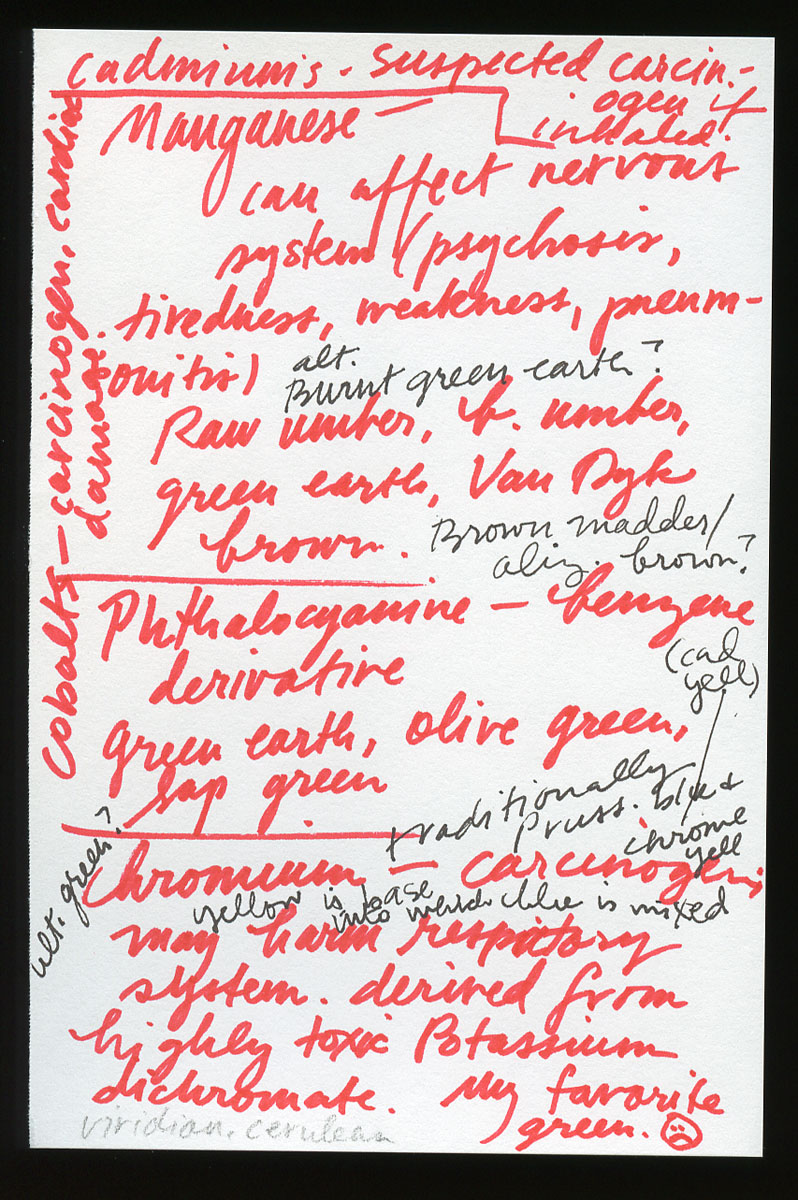 |
| This single notepad page logs some of Elspeth's color-by-color discoveries concerning carcinogens present in various paints, as well as a few known side affects from use of a particular paint. Chemical compositions vary from manufacturer to manufacturer. Additionally, names of colors vary across brands and across time because each color has its own history. Thus, color names do not mean the same thing from one manufacturer to another (i.e., colors may match approximately, but not exactly), nor does the behavior of a color, in its interaction with other colors, exactly match across brands. Then there is the language of chemistry which, notwithstanding its indispensable usefulness, adds its own layer of complexities. |
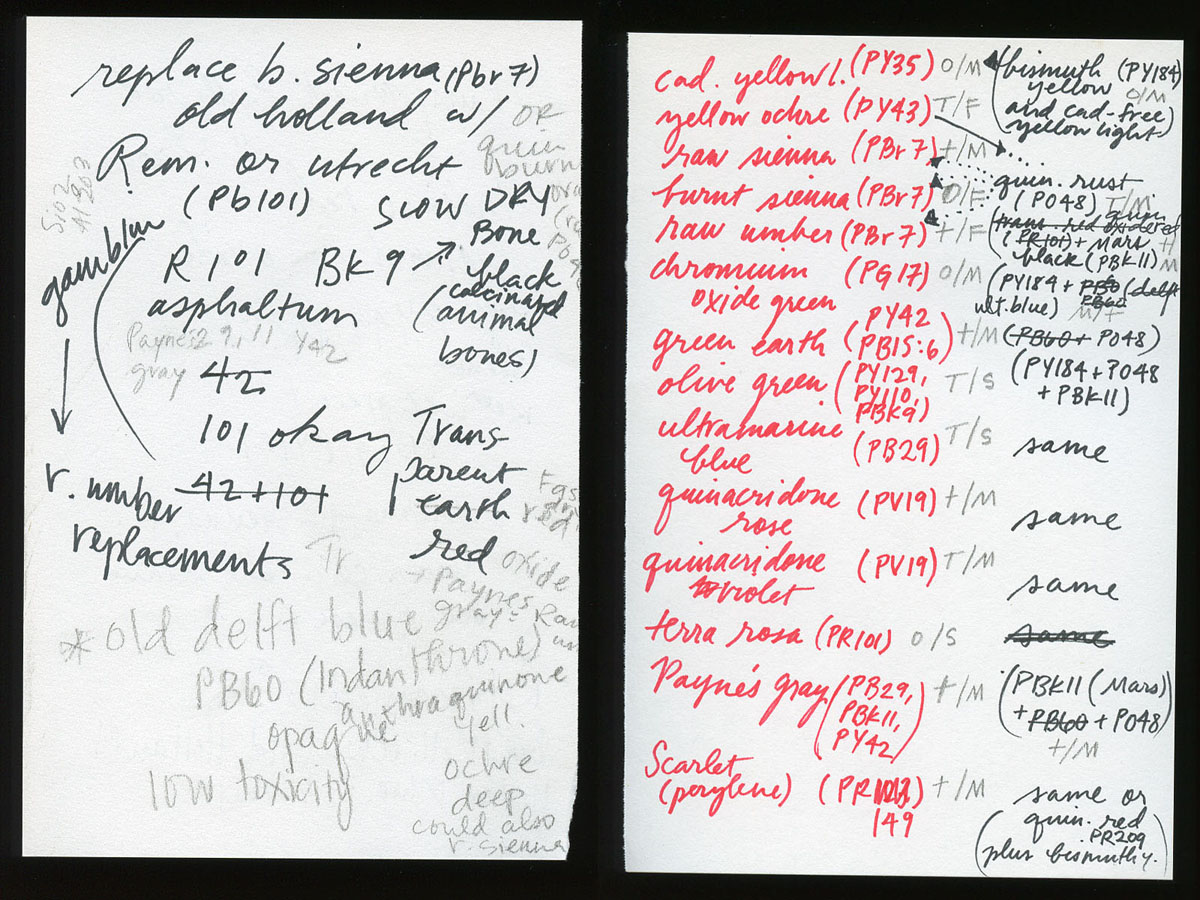 |
| Two more note pages from Elspeth's research revolve around the importance of Color Index International pigment identification numbers. These are indispensable in reconciling brand colors across manufacturers. They are similarly valuable in identifying non-toxic or non-allergenic replacements for problem colors. The matter of replacement is particularly challenging. For example, Cadmium Yellow has long been a staple for various subjects in my paintings. We found a non-toxic replacement that was a good enough match for hue; however, the replacement(s) do not behave the same way that Cad Yellow behaves when mixed even with a small amount of White. Cad Yellow retains its color warmth, but the replacement(s) do not. In the context of glazing, this meant adding the replacement(s) after glazing, not before. And even then, the result is not quite acceptable. This is the kind of trial and error that takes a great deal of time, and can unsettle many years of habit. Finding a color match is only the beginning of figuring out how to integrate it into the painting techniques to which one's palette is subjected. We found the Color of Art Pigment Database enormously helpful—and free. |
vehicles
Toxicity in any particular medium usually pertains to an additive that has been incorporated into the vehicle, such as a drying agent (e.g., alkyd, mastic, copal, etc.).
Generally speaking, a medium that is simply an oil does not pose a health problem unless a person is allergic to what the oil is made from (e.g., linseed, safflower, walnut, etc.). A person allergic to walnuts, for example, would have problems painting with walnut oil, but not because the walnut oil is toxic. Finding a different oil (e.g., linseed, safflower, poppy, sunflower, etc.) or using no medium at all might solve the problem. In the case of walnut oil, for example, the important difference between walnut oil and walnut alkyd medium is the addition of alkyd to the latter as a drying agent.
The oil one uses can depend upon a broad spectrum of considerations such as:
Personal allergies and sensitivitiesSuch factors are spread not only across personal tastes, but brands of available substances and materials; that is, not everything by the same name is the same from one manufacturer to another.
Choice of techniques or methodologies employed in creating a painting
The support for the painting and the manner in which it is prepared
Compatibility with other materials and substances used in one's approach to painting
Drying time available for a particular project
Desired viscosity or texture in terms of application
Desired visual results in terms of the appearance of the paint when dry
Cost and general availability are also factors.
And then there is the ever elusive matter of whether a painting is archivally sound.
To put it mildly, this and other puzzles-to-solve regarding the technical side of oil painting is a very long and essentially lonely journey of research, trial, error, and success.
erasure
Removal options, as a general rule, span a continuum ranging from over-painting to sanding or scraping, even solvents (thinners, terps, etc.). And whether or not a particular approach to removal is suitable at any given time depends upon another bewildering array of factors. Inasmuch as this article focuses on toxicity, toxicity is the only aspect of removal discussed here.
A rag is the simplest and least toxic method for removing wet paint, but how a rag is used depends upon the stability of any substrata in the affected area. However, rag-use is by no means limited to rubbing. I often find that carefully pressing a clean rag onto the surface of a painting and just as carefully lifting the rag from the surface can achieve erasure without disturbing surrounding areas. (Masking, of course—using a variety of techniques—is often an effective method of erasure not only after the fact, but—more importantly—before.)
If the removal involves dry or drying paint, too dry for the use of only a rag, pure oil—lavender (spike) oil, pure terps, odorless mineral spirits—can serve as a removal agent. But be aware that the oil, the rag, and the manner in which the rag is used can also remove strata.
Using a solvent for erasure almost certainly introduces toxic chemicals, which must be dealt with appropriately.
Scraping and sanding introduce particulates, which have to be dealt with as both airborne and topical hazards.
All of these factors affect clean-up as well as removal. Wearing a suitably rated mask or respirator and gloves, discarding used and removed materials, then following-up by wet-cleaning surfaces (paying due attention to the contents of any agents used in the process) are good standard practices.
Sunflower oil can also be used for brush cleaning.
glazing & sealing
Glazing, particularly the methodology of achieving desired color by the accumulation of tinted, translucent layers of pigment suspended in medium (varying in opacity), can present the need or desire to seal substrata so that subsequent applications of either glazes or impasto do not jeopardize work already completed. Maxfield Parrish and J. M. W. Turner are famous for this approach to painting. Whether or not an artist takes this approach to the degree that Parrish did, the challenges involved are the same; that is, ensuring that substrata are sealed off from the very real possibility that the addition of more layers will undo the integrity of layers already applied. Without going into a tedious explanation of this particular approach to color and image creation, suffice it to say that what to use as a sealant involves highly toxic options. Our solution to this has come down to Gamblin's Solvent Free Medium, available as either a liquid or a gel. Other options are, of course, available, but they do contain solvents and solvents are toxic to varying degrees. Nevertheless, Gamblin's achievement is very pungent when applied in quantity.
If one's approach to glazing is essentially over-painting (i.e., just another impasto layer), the foregoing isn't a problem.
Finally, at least in terms of our approach to glazing, there is the matter of what we've come to refer to as a dry-brush glaze. The principle of this technique is the same as glazing ala Parrish, except that little or no oil or medium is present. The application is by stippling, and the thickness or thinness of that application determines the degree to which the glaze obscures substrata, in much the same way as mist or fog.
Whether or not a finished painting is sealed at all or is waxed or is placed under glass or is coated with a final glaze is a matter of taste and judgement. Selection of material(s) for sealing involves the same kind of attention to allergies and toxicities as already described.
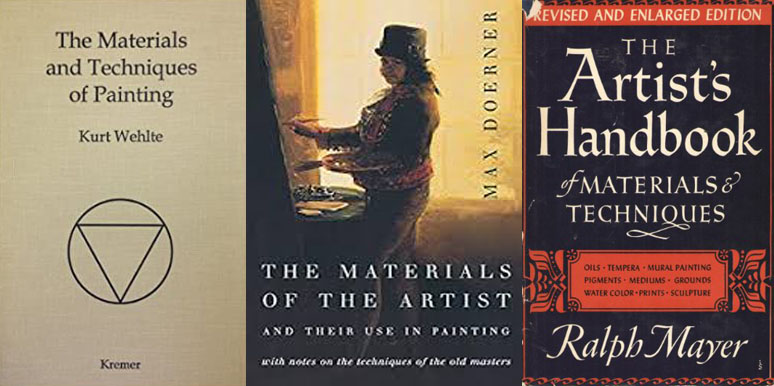
getting answers
Published sources such as The Artist's Handbook by Ralph Mayer, The Materials and Techniques of Painting by Kurt Wehlte, and Max Doerner's The Materials of the Artist are excellent, but may not contain the latest information. Advances in the science and technology of painting are blessedly moving on apace. (That is one of the primary reasons that the Studios' approach to creating artworks tries to maintain a clear focus on time-tested principles while keeping a sharp eye out for advances in tools and materials.) Consequently, their strength is at least background, which is important in knowing how to approach a question or subject, which involves finding out whether the question has been posed, who posed it or is posing it, and who may have answered it or tried to answer it. These published sources also provide insight into how problem domains have been structured or decomposed into constituent problems, questions, and answers; and what solutions have been tried. It's never enough to simply get an answer: You have to know whether the answer matches your question.
Internet forums have their uses, but it's important to know the background or competency of any source. Furthermore, even a relatively little time spent canvasing forums makes it evident that a full circle of opposing opinions is available on any subject. It's also wise to be at least cautious about pronouncements of the always or never persuasion.
Safety Data Sheets (SDS, also known as a Material Safety Data Sheets – MSDS) are a good place to start.
Don't hesitate to contact manufacturers directly. The responsiveness of any manufacturer is an important part of evaluating the quality or integrity of the information they provide. Asking for detail about anyone's manufacture of a product is a sensitive proposition, but so is dealing with the consequences of product use. No small part of our choices in these matters derives from the willingness and openness of the manufacturers involved.
Finally, it's easy for a studio artist, working alone most of the time and perhaps feeling alone the rest, to come to a dead end even after all imaginable resources have been exhausted. Sometimes the most careful and ardent research turns up nothing but diametrically opposed opinions from seemingly equally qualified sources. Sometimes a particular question is so nuanced that it seems impossible to find a reliable answer that adequately addresses the particular subtlety in question. We hit one such impasse during the research from which this article derives. Quite by accident (which is never the real story behind solutions), we came across an article involving the Straus Center for Conversation and Technical Studies. At that point my long-ago background as a journalist came into play, and with nothing more than a directory of senior staff in this imposing institution, we sent an email. Not every "cold contact" turns out, but this one did and the response we received was not only gracious, but pivotal. So, when you've done your homework and your need is great, be fearless. There are a great many more kind-hearted and generous people in this world than apprehension can imagine.
al's approach to the new palette
I go in for a Maxfield Parrish approach to painting; not hook, line, and sinker, but certainly to the degree that it achieves the qualities of color and texture I'm after. I also rely heavily on dry-brush glazing, and will over-paint with relatively opaque layers as it suits. Currently, my solution is to use Gamblin's Solvent Free Gel as the inter-layer sealant, whenever I feel like substrata need protection. Otherwise, I keep adding layers without such a sealant. As remarked, above, the Gel is particularly pungent, which poses a significant problem for the household whenever I paint indoors.
As documented in connection with a recent commission, my solution for pungency involves an outdoor studio where I can lather on the Gel whenever I need to do so and let the painting off-gas for whatever time it takes. However, the off-gassing can take weeks, so I am currently also in the process of sealing off the indoor studio so that I can bring paintings back indoors even before they're sufficiently odor-free (if the need arises during winter months). This introduces the need to paint in and around the temperature extremes of an alpine desert, which makes plein air painting impossible for a sizable portion of the year, even when daytime highs permit.
The planned solution also involves an impeller, but that's presently down the road a bit, after the partitioning of the studio is completed. The studio has a two-story ceiling, which means that the ground floor at least needs to be sealed. The need to do so for the upper floor is yet to be determined.
Unless I'm working on a commission with a deadline, a drying agent isn't really necessary. I frequently paint without oil. However, this is one approach to dryness to which Elspeth introduced me and which I have found not only useful in reducing drying-time, but very pleasing in the resulting visual quality of application of the "dry" paint. The process involves laying out one's palette on a sheet of palette paper, but not using the glossy (nonporous) side of the sheet. Instead, set out the paints on the absorbent side and let the paper soak up much of the oil from the paints. Not only is drying time abbreviated, but a stroked application of paint (as opposed to stippling, for example) yields a very pleasing scuff-trail.
I do keep safflower oil on hand if erasure is needed. It works well enough if the paint hasn't been drying for too long.
This is my Tuulien Palette (named partly because I simply enjoy naming things, but also because I've worked with several palettes over the years). The headings Indoor and Outdoor pertain to where the painting needs to be when I use them. (I should probably explain that a 4 ft. x 8 ft. painting is not unusual for me, and that such a size can overwhelm even a largeish area when a pungent substance is applied to its entire surface.)
Indoor hueselspeth's approach to the new palette
Cadmium Free Yellow Light
Hansa Yellow
Hansa Deep Yellow
Yellow Ochre
Indian Yellow
Raw Sienna
Raw Umber
Burnt Sienna
Quinacridone Rust
Quinacridone Red
Quinacridone Rose
Quinacridone Violet
Perylene Scarlet
Ultramarine Blue
Titanium White Sunflower
Zinc White
Outdoor hues
Cadmium Yellow Light
Cadmium Yellow Medium
Bismuth Yellow
Phthalocyanine Blue
The following pages from Elspeth's painting journals recount some of the experimentation, disappointments, and successes involved in her transition to a new, safer palette.
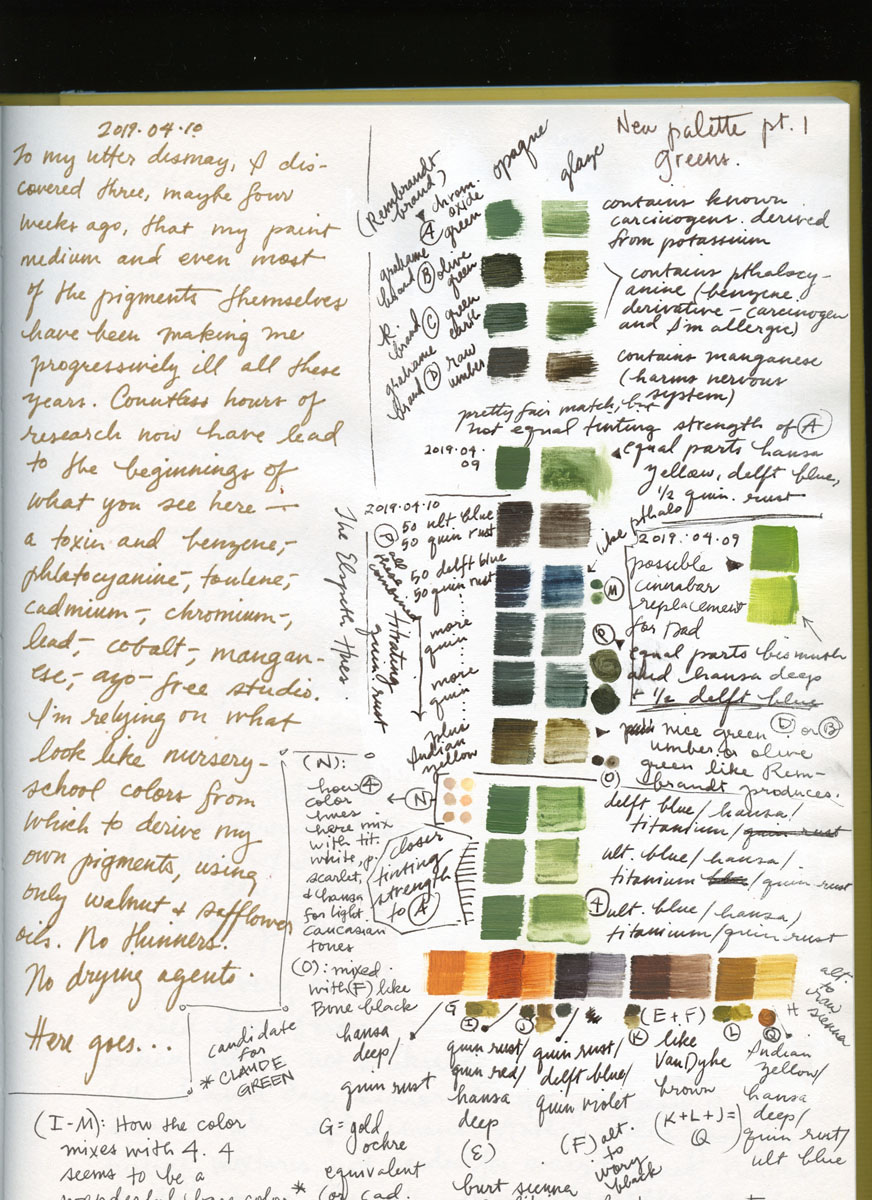
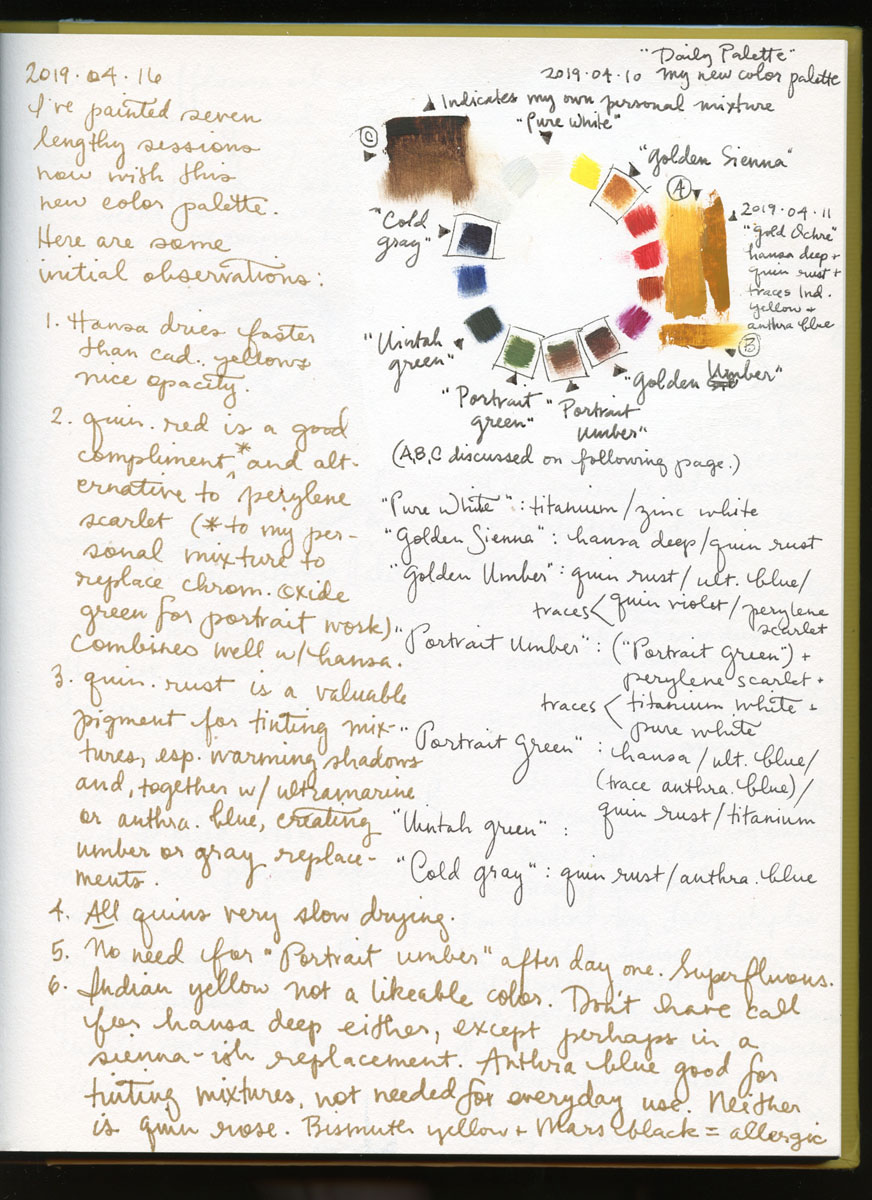
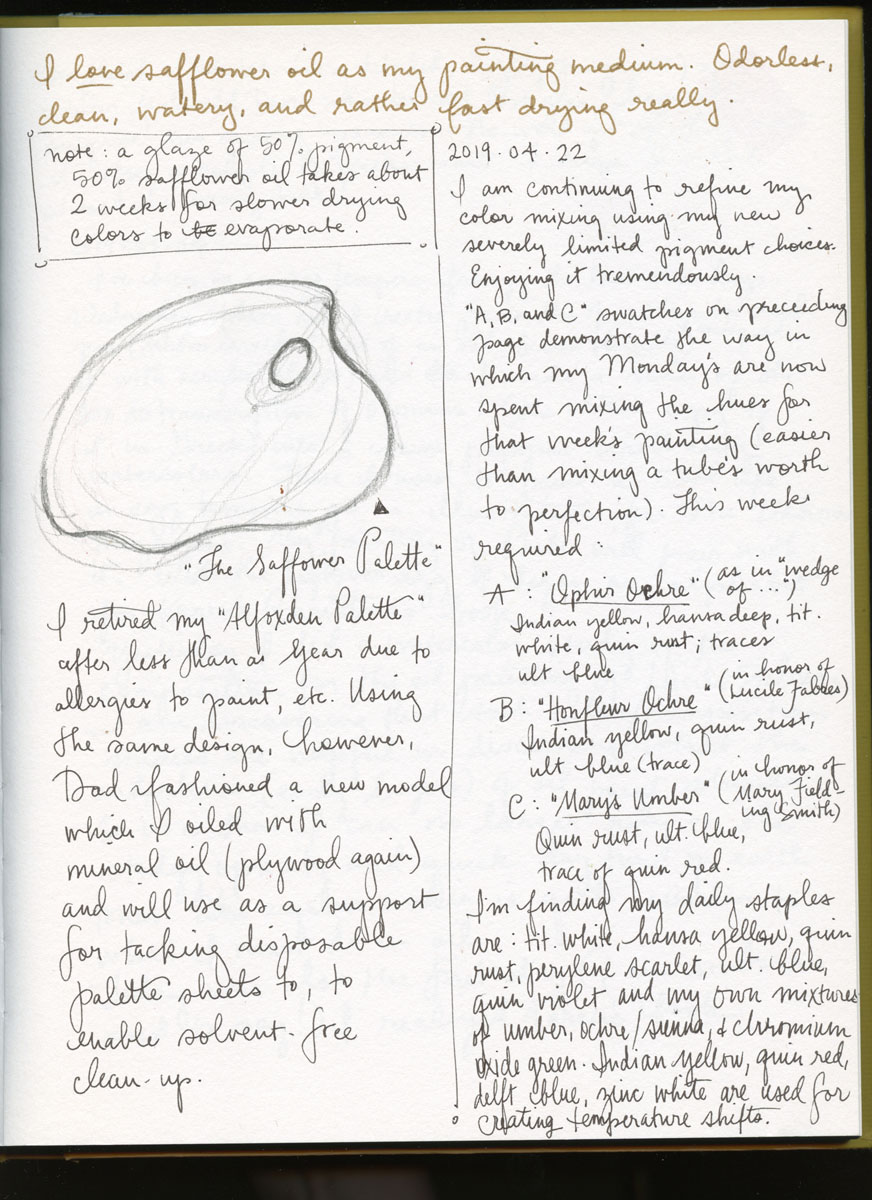
Tags: 2020, Tips and techniques, Tools supplies and operations
Browse articles by year: 2025 . 2024 . 2023 . 2022 . 2021 . 2020 . 2019 . 2018 . 2017 . 2016 . 2015 . 2014 . 2013 . 2012 . 2011 . 2010 . 2009 . 2008 . 2007 . 2006 . 2005 . 2004 . 2003 . 2002 . 2001 . 2000 . 1999 . 1998 . 1997 . 1996
Browse articles by topic: Art lessons . BenHaven Archives . Blank art diaries . Fine art photography . Framing . Illustration . Inspiration and creativity . Isles of Rune . Limited Editions Collection . My Fathers Captivity . News . Novellas . Oil paintings and prints . Operations announcements . Orders and shipping . Overview . Portfolios . The Papers of Seymore Wainscott . Project commentaries . Recipes by Nancy Young . Recommended reading . Recommended viewing . Temple artworks . The Storybook Home Journal . Tips and techniques . Tools supplies and operations
Browse articles by topic: Art lessons . BenHaven Archives . Blank art diaries . Fine art photography . Framing . Illustration . Inspiration and creativity . Isles of Rune . Limited Editions Collection . My Fathers Captivity . News . Novellas . Oil paintings and prints . Operations announcements . Orders and shipping . Overview . Portfolios . The Papers of Seymore Wainscott . Project commentaries . Recipes by Nancy Young . Recommended reading . Recommended viewing . Temple artworks . The Storybook Home Journal . Tips and techniques . Tools supplies and operations